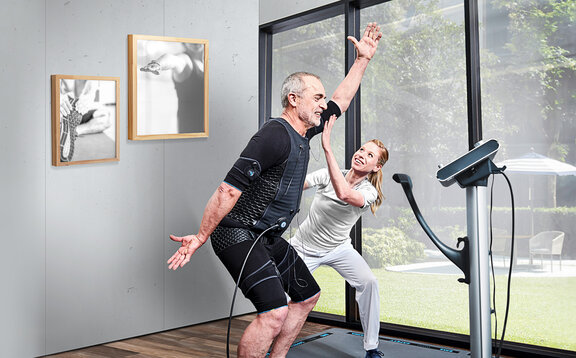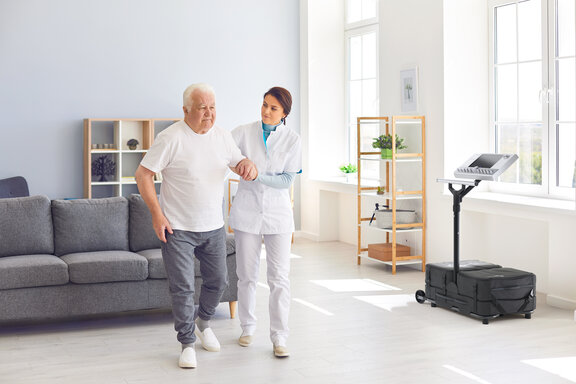Stay Strong and Active
at any age
with Whole-Body EMS

EMS-Training provides efficient and targeted muscle activation, making it a powerful solution for both prevention and therapy. By stimulating all major muscle groups, it helps counteract early muscle loss and supports long-term muscle health. For older individuals already experiencing sarcopenia, EMS can slow down muscle degradation, preserving strength, mobility, and overall vitality. This innovative technology promotes longevity and enhances quality of life at any stage.
Efficacy and Safety Into Higher Age
The efficacy and safety of EMS applications for prevention and treatment of sarcopenia have been proven in multiple studies - even in seniors who were well over 75 years old.[1-5]
High Intensities - Low Sense of Stress
EMS allows for the rapid and reliable attainment of high training intensities. This not only strengthens muscles throughout the body but also enhances their functionality - all with minimal perceived exertion.
Positive Effects on Strength, Muscle Mass and Function
Already with low intensity exercises, electromyostimulation recruits all major muscle groups, reduces body fat and increases lean muscle mass. Muscle strength and functionality also improve.[1-5]
Expert Opinions: EMS for Prevention of Age-Related Muscle Loss & Sarcopenia
What is
Sarcopenia?

The aging process often brings about a general and progressive loss of muscle mass and strength. The severe and widespread loss resulting from the physiological process of muscle degradation is known as sarcopenia. Its consequences can be grave. Muscle wasting in old age and sarcopenia can make daily life challenging for those affected.[7-20]
Muscle Strength During the Course of Life
Starting at age 50, muscle mass decreases by roughly 1-2% and muscle strength by 1.5-5% per year.[6] Lifestyle factors, like limited exercise and a poor, low-protein diet can speed up this development radically.[7,21] A lack of vitamin D intake also contributes to the weakened muscle strength typically seen in sarcopenia.[22] As these factors converge, functional ability lessens and personal mobility becomes increasingly compromised.[23] This can severely impact quality of life and mental wellbeing.
Build and maintain muscle mass.
Slow down age-related muscle loss.
EMS is a one-stop, long-term solution!
Studies on EMS for
the Prevention of Sarcopenia
Various studies have confirmed the efficacy and safety of electromyostimulation training in preventing and treating age-related muscle loss and sarcopenia. The findings include a positive impact on muscle mass, strength, function, and overall performance.[1-4]
Electromyostimulation had a positive effect on appendicular muscle mass and abdominal fat mass.
Conclusion:
EMS-Training proved to be...
- ...an effective, safe and attractive training method for non-athletic seniors at increased risk of sarcopenia and obesity.
- ...a technologically supported exercise programme in prevention and therapy for sarcopenia and regional fat accumulation.
- ...a particularly suitable option for people who cannot or do not want to exercise conventionally.
In sarcopenia patients with orthopaedic and/or cardiac indications, EMS application was a safe and effective way to improve leg muscle function and strength after only four weeks.
Conclusion:
EMS-Training proved to be...
- ...a promising approach to enhance muscular and functional capabilities for individuals in rehabilitation programs or clinical settings who are in a state of deconditioning.
- ...a viable option to further improve the health status of rehabilitation patients.
For older women over 70 with sarcopenic obesity, EMS was shown to safely and effectively increase muscle mass and functional capacity. The study also showed that protein supplementation alone did not increase the effect of Whole-Body EMS.
Conclusion:
EMS-Training proved to be...
- ...an attractive therapy option for people who are not motivated or able to do intensive conventional exercises.
EMS provides a compelling option, particularly for seniors who may be unable or unwilling to partake in traditional training programs, but who still wish to sustain or enhance their body composition and physical function over the long term.
Further Reading on the Benefits
of Whole-body EMS in Sarcopenia Patients
How does sarcopenia develop and what risk factors promote its development? Who is affected and what impact does the condition have on everyday life? What can be done preventively? What are the treatment strategies of choice?
- Kemmler W, von Stengel S. Clin Interv Aging. 2013;8:1353-1364.
- Teschler M et al. J Cachexia Sarcopenia Muscle. 2021;12:843-854.
- Kemmler W et al. Osteoporos Int. 2016;27:3261-3270.
- Kemmler W et al. Front Physiol. 2018;9:573.
- Kemmler W, Schliffka R, von Stengel S. J Strength Cond Res. 2010;24:1880-1887.
- Keller K, Engelhardt M. Muscles Ligaments Tendons J. 2013;3(4):346-350.
- Cruz-Jenthof AJ et al. Age and Ageing. 2019;48:16-31.
- Beaudart C et al. PLoS One. 2017;12:e0169548.
- Schaap LA et al. J Gerontol A Biol Sci Med Sci. 2018;73:1199-1204.
- Morley JE et al. J Am Med Dir Assoc. 2011;12:403-409.
- Dos Santos L et al. J Cachexia Sarcopenia Muscle. 2017;8:245-250.
- Beaudart C et al. J Cachexia Sarcopenia Muscle. 2017;8:238-244.
- Won Go L et al. Korean J Fam Med. 2013;34:281-288.
- Morley JE. Rev Invest Clin. 2016;68:59-67.
- Sayer AA et al. Diabetes Care. 2005;28:2541-2542.
- Bahat G, Ilhan B. Eur Geriatr Med. 2016;6:220-223.
- Bone AE et al. Chron Respir Dis. 2017;14:85-99.
- Chang KV et al. J Am Med Dir Assoc. 2016;17:1164.e7-64.e15.
- Cawthon PM et al. J Gerontol A Biol Sci Med Sci. 2017;72:1383-1389.
- Akune T et al. Geriatr Gerontol Int. 2014;14:695-701.
- Liguori I et al. Clin Interv Aging. 2018;13:913-927.
- Kim TN, Choi KM. J Bone Metab. 2013;20(1):1-10.
- Lang T et al. Osteoporos Int. 2010;21:543-559.

